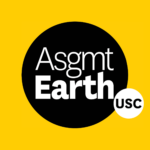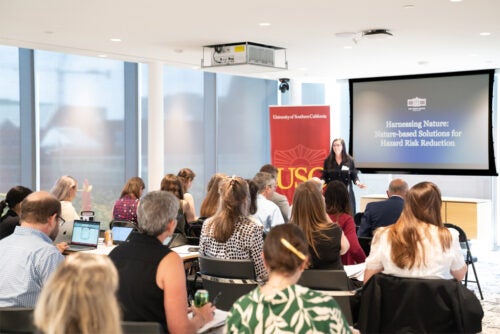
USC Dornsife Public Exchange and the White House Office of Science and Technology Policy (OSTP) work together to advance use of nature-based solutions to tackle climate change
 Los Angeles epitomizes the many climate-driven hazards that confront cities today — wildfires, air pollution, heat waves, coastal erosion, flooding, and drought. As the effects of climate change intensify, cities worldwide are increasingly investing in infrastructure projects to safeguard their communities from escalating risks.
Los Angeles epitomizes the many climate-driven hazards that confront cities today — wildfires, air pollution, heat waves, coastal erosion, flooding, and drought. As the effects of climate change intensify, cities worldwide are increasingly investing in infrastructure projects to safeguard their communities from escalating risks.
Urban infrastructure projects often rely on engineered designs and components, such as the cement walls lining the L.A. River, to reduce flooding risks. However, a new focus on integrating built and natural infrastructure promises better environmental, social and economic outcomes. In Los Angeles, one example is the USC Public Exchange Urban Trees Initiative, which aims to enhance resilience to rising temperatures by expanding tree coverage, particularly in vulnerable communities.
While nature-based solutions can be cost effective in reducing hazards such as coastal flooding or urban heat islands, they face challenges. For example, while studies show that living shorelines can be as effective at reducing coastal erosion as conventional gray infrastructure methods like seawalls, and can provide additional benefits (such as habitat and recreational opportunities), there is no standard manual for constructing living shorelines. The approach might depend on factors such as local ecology, wave energy and erosion rates. They can also be harder to fund and permit relative to traditional engineered structures made of concrete and steel.
To realize the potential of nature-based solutions across the United States, in 2022 the White House launched a roadmap to unlock the potential of these solutions, including by prioritizing additional research. “Collaboration between government institutions, civil society, academia and the private sector is key to harnessing the power of our built and natural environment to reduce hazards,” said Doug Mason, assistant director for nature-based solutions in the White House Office of Science and Technology Policy (OSTP).
Forging collaborative solutions
To that end, Public Exchange, based at the USC Dornsife College of Letters, Arts and Sciences, worked together with OSTP to host a day-long workshop titled “Harnessing Nature: Using Nature-Based Solutions for Disaster Risk Reduction.” The meeting convened leaders in nature-based solutions to compare and integrate academic and practitioner perspectives, establish a shared understanding of the evidence base for nature-based approaches, and explore strategies to clear roadblocks and advance projects on the ground.

“Deploying nature-based solutions more quickly requires breaking down the typical silos between researchers, policymakers and those doing the work on the ground,” said Monica Dean, Climate and Sustainability Practice director. “Public Exchange was built to reimagine the way researchers and problem solvers work together and has been successfully building projects that have accelerated climate research for real-word impact.”
Workshop participants identified critical research gaps hindering the widespread implementation of nature-based solutions. One major challenge is the lack of a central repository for existing information and analytical resources, making it difficult to harness past experience and develop new projects quickly. Another problem is the absence of standard engineering guidelines for nature-based solutions like there are for traditional infrastructure such as retaining walls. Advances in AI and support from research universities could help solve these problems by bringing together diverse sources of information and leveraging research ingenuity to develop effective, evidence-based approaches.
Public Exchange is leading one such project — building and testing new approaches that merge engineering, design, virtual reality and community engagement strategies to reimagine and redesign the L.A. River to restore habitat and build flood resilience. This innovative collaboration between the City of Los Angeles Bureau of Engineering, the U.S. Army Corps of Engineers, and other local and state agencies, and Clockshop, a local nonprofit, aims to support new data and standards for nature-based solutions design. The L.A. River Project demonstrates the ways in which research universities can advance the use of nature-based solutions and reduce risks to residents.